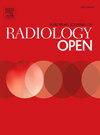预测急性缺血性脑卒中静脉溶栓后出血转化的定量CT灌注衍生在线动态图
IF 2.9
Q3 RADIOLOGY, NUCLEAR MEDICINE & MEDICAL IMAGING
引用次数: 0
摘要
目的探讨CT灌注(CTP)对急性缺血性脑卒中(AIS)静脉溶栓(IVT)后脑灌注的诊断价值及其对出血转化(HT)的预测能力。方法回顾性分析55例IVT前行CTP的AIS患者。收集临床信息,如美国国立卫生研究院卒中量表(NIHSS)评分和房颤(AF)史。在病理半球测量CTP参数,包括脑血流量(CBF)、脑血容量(CBV)、平均传递时间(MTT)、通透性表面积积(PS)、到达最大时间(Tmax)、到达峰值时间(TTP)。相对数值(rCBV, rCBF, rMTT, rPS, rTmax, rTTP)计算为病理与无症状半球ROI比率。HT组与非HT组的比较采用Student’s t检验和Mann-Whitney U检验。采用ROC曲线和Logistic回归分析评价模型预测值。Delong的测试比较了参数之间的AUC差异。用R-shiny建立动态模态图模型并进行评价。结果入院时NIHSS评分、IVT前NIHSS评分、IVT后NIHSS评分、出院时NIHSS评分、AF、PS、rPS均显著高于非ht组(p <; 0.005)。ROC曲线和logistic回归分析显示,包括IVT、AF和rPS前NIHSS评分的联合模型的AUC最高,为0.899(95 % CI:0.814,0.984; p <; 0.001)。结论动态图模型结合IVT前NIHSS评分、AF和rPS可作为预测AIS患者IVT后HT风险的实时可视化工具。本文章由计算机程序翻译,如有差异,请以英文原文为准。
A quantitative CT perfusion-derived online dynamic nomogram for predicting hemorrhagic transformation after intravenous thrombolysis in acute ischemic stroke
Purpose
To evaluate the diagnostic value of cerebral perfusion and its predictive ability of hemorrhagic transformation (HT) in acute ischemic stroke (AIS) after intravenous thrombolysis (IVT) using CT perfusion (CTP).
Methods
Retrospective cohort of 55 AIS patients who underwent CTP before IVT was included. Clinical information, such as the National Institutes of Health Stroke Scale (NIHSS) score and history of atrial fibrillation (AF), were collected. CTP parameters, including cerebral blood flow (CBF), cerebral blood volume (CBV), mean transit time (MTT), permeability surface area product (PS), time-to-maximum (Tmax), time to peak (TTP), were measured in pathological hemispheres. Relative values (rCBV, rCBF, rMTT, rPS, rTmax, rTTP) were calculated as pathological-to-asymptomatic hemisphere ROI ratios. Comparisons between HT and non-HT groups were conducted using Student’s t-Test and Mann-Whitney U test. ROC curve and Logistic regression analysis were used to evaluate model predictive values. Delong's test compared AUC differences among parameters. Dynamic nomogram model was constructed with R-shiny and evaluated.
Results
NIHSS score at admission, NIHSS score before IVT, NIHSS score after IVT, NIHSS score at discharge, AF, PS and rPS were significantly higher than those in the non-HT group (p < 0.005). ROC curve and logistic regression analyses revealed that the combined model including NIHSS score before IVT, AF, and rPS displayed the highest AUC of 0.899 (95 % CI:0.814,0.984; p < 0.001).
Conclusion
Dynamic nomogram model combined NIHSS score before IVT, AF and rPS may act as a real-time visualization tool in the prediction of HT risk after IVT in patients with AIS.
求助全文
通过发布文献求助,成功后即可免费获取论文全文。
去求助
来源期刊

European Journal of Radiology Open
Medicine-Radiology, Nuclear Medicine and Imaging
CiteScore
4.10
自引率
5.00%
发文量
55
审稿时长
51 days
 求助内容:
求助内容: 应助结果提醒方式:
应助结果提醒方式:


